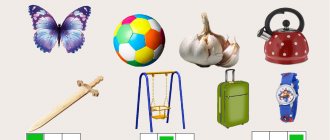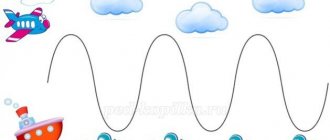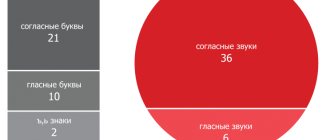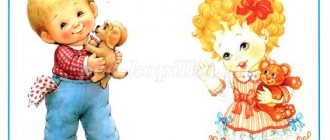Differentiation of sounds [Z]-[F]
- Speech therapist.No
- Sound differentiation
- Differentiation of sounds [Z]-[F]
1) Make sounds
| Z tongue below, lips smiling (see articulation of sound [Z]) | AND tongue up, lips rounded (see articulation of sound [Zh]) |
The sounds are voiced, hard consonants, colored blue.
2) Pronounce (read) syllables
|
|
|
|
|
|
|
|
|
|
3) Come up with words with the sounds [Z] and [Zh] at the beginning and in the middle of the word, make diagrams
Sample:
| Z Lawn Bunny Z | AND Knife Yolk F |
If the child does not know the letter, draw a picture and color the corresponding cell (the place of the sound in the word) blue.
4) Pronounce (read) syllables, words in pairs
zha-za
|
|
|
zho-zo
|
|
|
ju-zu
|
|
|
zhi-zi, zhi-zi
|
|
|
other combinations
|
|
5) Pronounce (read) words with sounds [Z] and [Zh]
|
|
|
|
6) Conjugate sentences
- I took Zhenya's skis.
- I noticed a snake in a puddle.
- I skied with Zina.
- I called Zhenya and Zina to dinner.
- I showed Zoya and Zhanna the hedgehog.
- I light an iron lighter.
Sample:
- I made a wish.
- You made a wish.
- He (she) made a wish.
- We made a wish.
- You made a wish.
- They made a wish.
7) Say (read) sentences
- Zakhar loads the gun.
- Zhenya deserved the award.
- The dog lay and licked his paw.
- Zhenya was cutting rye bread.
- We have large ore deposits.
- Zhenya helped detain the enemy.
- I held an iron nail in my hand.
- The foal ran into the yard and neighed.
- A green moth landed on a yellow stem.
- He shouts to the whole market as if there was a fire.
- We will go to the meadow and take a haystack from it.
- The bunnies sat at noon near a puddle on the lawn.
- We tied the Bug to the booth so that she wouldn’t run away.
- An iron saw squealed and a heavy hammer pounded.
- The green star has lit up, let's launch the spaceship there.
- The sun did not spare the heat for a good tan, and the wheat and rye were tanned too.
 Pronounce (read) and retell the text
Pronounce (read) and retell the text
For strawberries
Zhenya and Zina went to the forest to pick strawberries. They had bodies. But there were few strawberries in the forest. Near the birch tree Zhenya noticed a hedgehog. The hedgehog did not run, but curled up into a ball. Zhenya put the box on the ground. He called Zina. They wanted to take the hedgehog. Zina began to hold the box. Zhenya took a stick and rolled the hedgehog into the box.
Zhenya and Zina ran home. Instead of strawberries they have a live hedgehog. At home they gave the hedgehog milk. Zina wanted to leave the hedgehog. But Zhenya gave it. him into a living corner. There was already one hedgehog there. Hedgehogs have more fun together.
9) Learn a poem by heart
On the green lawn of the Bully there lived bunnies, There lived snakes and bear cubs, And snakes and hedgehogs. In the starry sky, fireflies lit lights, so that neither animal nor bird would get lost in that forest.
Differentiation of isolated sounds z and z
7. Select a sentence from the text with a certain number of words.
8. Raise the number corresponding to the number of words of the presented sentence (2, 3, 4, 5).
Development of syllabic analysis and synthesis.
The complexity of the syllabic analysis of a word largely depends on the nature of the syllables that make up the word and their pronunciation difficulty. The lighter the syllable, the more fused in pronunciation the sounds of the syllable that make it up, the easier it is to isolate it from the word. Therefore, children identify open syllables more easily and have difficulty identifying closed ones. A closed syllable is more difficult to pronounce because the sounds that make it up are less united in pronunciation and more independent of each other. Therefore, it is easier to divide a closed syllable into its constituent sounds in the process of dividing a word into syllables. Children represent one syllable as two ( a-r-buz, u-t-ka, do-m
). Therefore, in speech therapy work on the development of syllabic analysis and synthesis, special attention should be paid to identifying a closed syllable as a single whole.
Speech therapy work should take into account the stage-by-stage formation of mental actions. Therefore, at first the work is carried out based on auxiliary means, the materialization of the action, and later it is carried out in terms of loud speech. At subsequent stages of work, it becomes possible to transfer this action to the internal plane, implementing it on the basis of auditory-pronunciation ideas.
When forming a syllable analysis based on auxiliary means, it is proposed to clap or tap the word into syllables and name their number, or use the technique of perceiving the movements of the lower jaw with the back of the hand. The use of this technique is due to the fact that vowel sounds are pronounced with a greater opening of the oral cavity, with a greater lowering of the lower jaw than consonants. Since the number of vowels corresponds to the number of syllables, the number of movements of the lower jaw will correspond to the number of syllables in the word.
In speech therapy work on the development of syllabic analysis in speech terms, emphasis is placed on the ability to isolate the vowel sounds of a word. Children must learn the basic rule: there are as many syllables in a word as there are vowel sounds. Relying on vowel sounds allows you to eliminate and prevent reading errors such as omission of vowel sounds or their addition.
To develop the ability to determine the syllabic composition of a word based on vowels, preliminary work is necessary to develop the differentiation of vowels and consonants, highlighting the vowel sound against the background of the word and isolating vowel sounds from the word.
When differentiating vowels and consonants, an idea is given of the sounds themselves and the main features of their differentiation. Children clarify that these sounds differ in the method of articulation. So, when pronouncing vowel sounds, the air stream does not encounter an obstacle on its path, it passes freely, and when pronouncing consonant sounds, the air stream on its path encounters an obstacle in the form of a bow or a narrow gap. Vowels and consonants also differ in the nature of their sound. Vowel sounds consist only of the voice. Consonant sounds consist either of noise alone or of voice and noise. Vowels can be sung and drawn out for a long time. And finally, attention is drawn to the fact that vowels form a syllable and are syllabic sounds. To consolidate differentiation, the following technique is used: the speech therapist names vowel and consonant sounds, children raise a red flag if the sound is a vowel, and a blue flag if the sound is a consonant.
Reasons for incorrect pronunciation
Incorrect pronunciation of hissing and whistling sounds is called sigmatism.
The reasons why it may appear are various. The most common ones are the following:
- Features of the structure of the articulatory apparatus: shortened frenulum, “Gothic” palate (when the child has a high arch of the hard palate), structural defects of the jaw (bad bite), nasopharynx.
- Weak innervation of the tongue muscles, or, on the contrary, high muscle tone.
- Impaired phonemic awareness.
- Delay in the development of the child’s nervous system.
Problems with sound pronunciation can also appear against the background of imitating the incorrect speech of an adult. It is important that the child hears correct, clear speech not only in lessons with specialists, but also at home.
Incorrect pronunciation of sound: types of sibilant sigmatism
Sometimes parents of a child who has problems with sound pronunciation turn to a speech therapist late for help. Or they even think that the baby has no problems with speech, due to the fact that they do not always know how this or that sound should be reproduced correctly. Each sound has its own articulatory position. By ear, it may seem that the child seems to pronounce it (doesn’t miss it or replace it, just “F” is heard), but at the same time he doesn’t always articulate it correctly.
The work is carried out individually, depending on the characteristics of the violation. There are several types of hissing sigmatism, characterized by incorrect position of the organs of the speech apparatus:
- Lower (the sound is softened).
- Rear-lingual (in this case, the position of the articulatory organs is as with the sounds G, X; this leads to the fact that the sound Z is pronounced noisily).
- Buccal (in this case, the tongue is motionless, the cheeks are puffed out, the teeth are closed, and a dull, booming sound is formed).
Mnemonics of tongue twisters for the sound “Z”:
Tongue twisters for automating the sound “Z” with the help of mnemonic tracks are easier and easier for kids to learn. When a child sees a chain of coherent pictures, he is not so afraid to start learning even complex text. Therefore, use mnemonics to learn tongue twisters. This will make your classes not only useful, but also fun.
Prevention of sound pronunciation correction and prediction
In addition to the speech therapy classes that the child attends in kindergarten or speech school, homework to eliminate speech disorders and sound correction is also recommended. Additional work with parents will help reinforce the material covered.
The teacher can invite parents to perform some exercises from a complex of articulation or breathing exercises with their child at home. If the baby still does not always correctly differentiate the sound, and in free speech replaces it with a similar sounding one, then adults are recommended to focus on this, offering the correct option.
Thus, work on correcting sound pronunciation will be carried out continuously: in the garden, on a walk, at home, which will lead to positive results.
The sooner speech therapy work begins, the sooner speech will become correct and all sounds will be brought to automatism.
Options for games with tongue twisters:
- Find words with the sound “Z” in the tongue twister;
- Find words where in the tongue twister the sound “Z” is at the beginning of the word, in the middle of the word;
- Come up with your own funny sentence using this word;
- Connect the two parts of the tongue twister and pronounce it;
- Say a tongue twister cheerfully, sadly, with fear, quietly, loudly;
- Guess with what intonation your partner pronounced the tongue twister;
- Say a patter and the intonation of a famous cartoon or fairy tale character (for example, the Wolf from Seven Little Goats or Matroskin the Cat from Prostokvashino, etc.);



